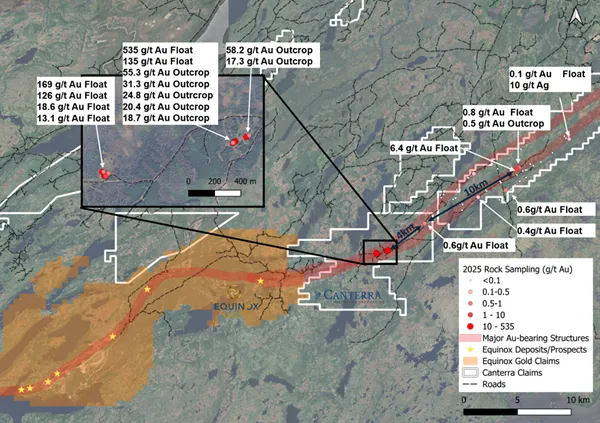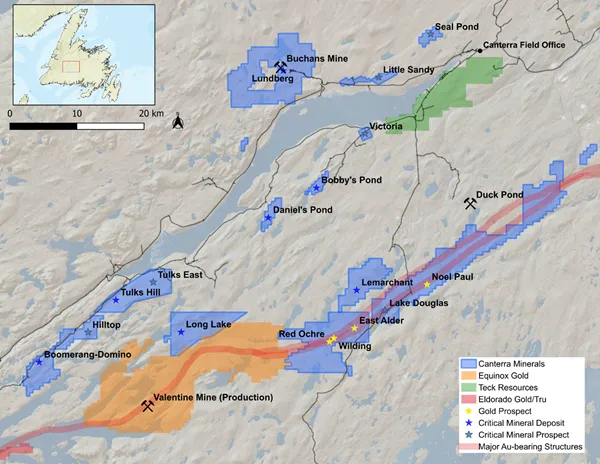Canterra Minerals Corp. (TSX-V: CTM) (OTCQB: CTMCF) is excited to report the latest prospecting results from its Wilding Gold Project. Wilding adjoins Equinox Gold's Valentine Mine, encompassing 55 km of the gold-bearing corridor that hosts Equinox’s new mine in the central Newfoundland Mining District.
This is significant because Equinox Gold’s Valentine Mine is soon to be Atlantic Canada’s largest gold operation, and Canterra’s prospecting results continue to highlight the exceptional gold potential of its nearby project.
Chris Pennimpede, CEO of Canterra Minerals, expressed his delight, stating:
These exceptional results, including over 500 g/t gold from our known zones, underscore the remarkable gold endowment of our Wilding Project.
With the first significant goal prospecting results from the next 50 km of the corridor and Equinox's Valentine Mine approaching production next door, we're in an enviable position along one of Canada's most exciting emerging gold trends. The timing couldn't be better as the district prepares for its transformation into a major gold-producing camp.
Learn more about Canterra Minerals’ exploration activities.
Wilding Gold Project Highlights include:
6 g/t Au 14km from the original discoveries
1 g/t Au 4km further demonstrates strong gold mineralization across the 55km strike length Wilding covers
Exceptionally high-grade results, exceeding 500 g/t Au, were found around the original discoveries. These are the highest-grade gold results ever reported on the project, confirming the strength of the Wilding gold system and comparing favourably with top intercepts from adjacent deposits at Valentine during its exploration phase.

Figure 1. Canterra prospecting highlights with callouts to significant samples at the Wilding Project. Results are derived form prospecting grab samples of both bedrock (outcrop) and transported material (i.e., float/boulders).
Early prospecting, completed just 10 km from the original discoveries, has already returned promising gold values. This suggests that the gold-bearing system stretches well beyond the initial find, giving the company a much larger target to work with.

Figure 2: Canterra’s Central Newfoundland Mining District properties.
What makes these results even more exciting is the presence of pathfinder elements such as copper, tellurium, and arsenic. In geology, these elements often form “halos” around gold mineralization, especially in what is referred to as nuggety orogenic gold systems, which are formed during mountain creation and result in variability in gold deposit grades. For investors, this is significant because these halos serve as a roadmap, helping geologists pinpoint areas most likely to yield high-grade gold.
Canterra is strengthening its district-scale exploration model. In plain terms, this means it is not just chasing isolated gold veins; it is building a case for a large, continuous gold system. With multiple new targets now identified, the stage is set for follow-up exploration that has the potential to unlock even more value for shareholders.
#About Canterra Minerals
Canterra Minerals has consolidated 100% of the copper-gold deposits (excluding the adjacent Valentine mine) in central Newfoundland, a first in the district’s history. Management believes this gives the company leverage over future discoveries in a historically prolific but fragmented mining camp.
Its projects are located near historic mines that produced copper, zinc, lead, silver, and gold. Its gold assets lie along a 55 km trend connected to Equinox Gold’s Valentine Mine. Canterra’s position in this emerging district places it early in the exploration cycle, as Newfoundland experiences renewed interest driven by recent high-grade gold discoveries.
#FAQs for Retail Investors
Why is a new gold discovery important?
A discovery can significantly increase the potential value of a company’s project, especially if early results point to size, grade, and continuity.
What does “grade” mean in gold exploration?
Grade refers to how much gold is in the rock, usually measured in grams per tonne (g/t). Higher grades generally mean more valuable rock.
How do prospecting results differ from drilling results?
Prospecting often involves surface sampling and early tests. Drilling provides a clearer picture of gold at depth, confirming the size and strength of the deposit.
What does “district-scale potential” mean?
It means the company’s land package is big enough, and geologically favourable enough, to possibly host multiple deposits across a large area.
What are “pathfinder elements” and why do they matter?
Elements like copper or tellurium often show up around gold systems. They act as clues, helping geologists target where the gold is most likely to be found.
How long does it take to move from discovery to a producing gold mine?
It can take years — from discovery, to resource definition, to feasibility studies, to permitting and construction. Early discoveries are just the first step in creating value.
Why focus on North America?
North America offers mining-friendly jurisdictions with strong infrastructure, skilled labour, and clear permitting processes, reducing risk compared to some global regions.
How can early discoveries affect share price?
Positive results can spark investor interest and drive share prices higher, but results must continue to build momentum through follow-up drilling and studies.
What is a nuggety orogenic gold system?
A nuggety orogenic system is a type of gold deposit formed during mountain-building events. The gold often occurs in coarse “nuggets” or pockets within veins, rather than being evenly spread out. This can lead to very high-grade results in certain drill holes, but also variability between samples. In short, when a project is described as orogenic, it means the geology matches some of the world’s most productive and profitable gold camps.